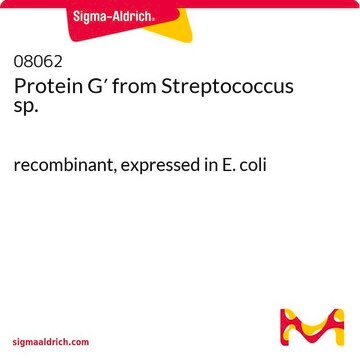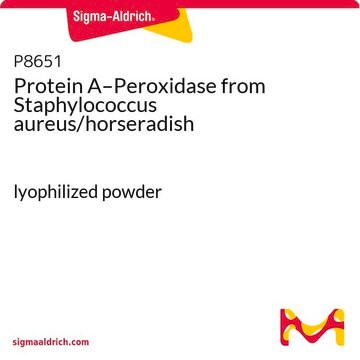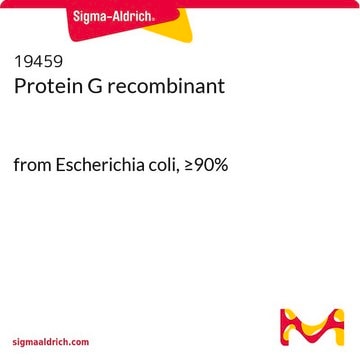P6031
Protein A from Staphylococcus aureus
Soluble, essentially salt-free, lyophilized powder, extracellular
Sinónimos:
Protein A resin
About This Item
Productos recomendados
biological source
Staphylococcus aureus
Quality Level
conjugate
unconjugated
form
essentially salt-free, lyophilized powder
capacity
7-14 mg/mg, solid binding capacity (human IgG)
solubility
H2O: soluble 1 mg/mL, clear, colorless
UniProt accession no.
storage temp.
2-8°C
Gene Information
Staphylococcus aureus subsp. aureus NCTC 8325 ... SAOUHSC_00069(3919448)
¿Está buscando productos similares? Visita Guía de comparación de productos
General description
Application
- to coat nitrocellulose sheet with protein A for immunoassay of agalactosyl IgG.
- as a blocking agent before the use of secondary antibody in immunohistochemistry.
- as a binding agent to antibody during antibody immobilization.
Biochem/physiol Actions
Protein A also participates in a number of different protective biological functions including anti-tumor, toxic, and carcinogenic activities. In addition to acting as an immunomodulator, it also has antifungal and antiparasitic properties.
Preparation Note
Disclaimer
Storage Class
11 - Combustible Solids
wgk_germany
WGK 3
flash_point_f
Not applicable
flash_point_c
Not applicable
ppe
Eyeshields, Gloves, type N95 (US)
Certificados de análisis (COA)
Busque Certificados de análisis (COA) introduciendo el número de lote del producto. Los números de lote se encuentran en la etiqueta del producto después de las palabras «Lot» o «Batch»
¿Ya tiene este producto?
Encuentre la documentación para los productos que ha comprado recientemente en la Biblioteca de documentos.
Artículos
Antibody fragmentation with our pepsin digestion protocol for IgG antibody fragmentation and preparation of F(ab’).
Nuestro equipo de científicos tiene experiencia en todas las áreas de investigación: Ciencias de la vida, Ciencia de los materiales, Síntesis química, Cromatografía, Analítica y muchas otras.
Póngase en contacto con el Servicio técnico








